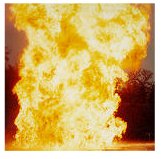
SUMMARY.
The occurrence of a deliberate attack on an LNG carrier can result in a major loss of containment with a subsequent threat to both the ship, its crew and the public.
A Boston company approached Lloyd’s Register Of Shipping (LR) to carry out a generic assessment of the consequences resulting from a deliberate damaging action against a membrane LNG tanker.
This assessment provided an overview of the typical consequences that would result from the following initiating events:
* Missile attack on the external hull
* External explosive device in a dingy placed next to the hull
The typical consequences of:
* Missile attack on the external hull
* External explosive device in a dingy placed next to the hull
CONCLUSIONS
* Loss of containment may occur through shock mechanisms caused by small amounts of explosive. There may not be a visible hole so the release to atmosphere would be minimal during the early stages of an incident. The amount of explosive required is difficult to predict:
* A CENSORED kg TNT equivalent is required to form a hole of 1 m diameter in the outer hull if detonated above the waterline.
* In addition to a 1m hole above the waterline, a CENSORED kg TNT equivalent will form a 5m radius hole below the waterline due to induced shock if detonated at the waterline itself
* A CENSORED kg TNT equivalent will form a 1m diameter hole below the waterline
* A missile or explosion will leave a large number of ignition sources near to the loss of containment
* There is a possibility of escalating failure of the ship structure due to embrittlement, followed by internal explosion caused by either rapid phase transition, or by gas air mix being ignited
* Ignition and sustained combustion of a vaporised LNG cloud under normal release conditions is difficult. However multiple ignitions are likely, probably resulting in a burn back to source.
* Unconfined LNG vapour cloud detonation type explosion has not been demonstrated in experimental work and is most unlikely in practice.
* External ignition will be a slow moving flame (~10m/s)
* Rapid Phase Transition will not light the gas cloud, but could cause damage to the ship or machinery though localised overpressures
* In Terms of pool spread, LPG and gasoline present a greater hazard than LNG
* The LFL for methane air mixtures is 5% volume so the LFL boundary is well within the visible cloud
* If a gas cloud is formed, and assuming that no ignition occurs, the flammable limits have been suggested as reaching up to 6km from the source. Experimental modelling using the TRACE software have suggested a 3km range of LFL at 5% by volume. It is unlikely that these distances would be reached due to local ignition sources being readily available.
* Experimental modelling using the FRED software tool suggests ~300m radius for a radiated heat from a pool fire capable of causing pain in 60 seconds
* As the gas cloud warms up the gas will become lighter than air and will rise away from the surface.
* As LNG will vaporise and is non-toxic, there is no significant direct environmental damage caused by a spill and hence no clean up costs other than those arising from secondary escalation factors.
* Calculations show that a fire from a single 25,000m3 cargo tank of a 125,000m3 vessel with a 1m2 hole would last approximately 1 hour and result in a pool fire of some 500m2 (~25m diameter).
END